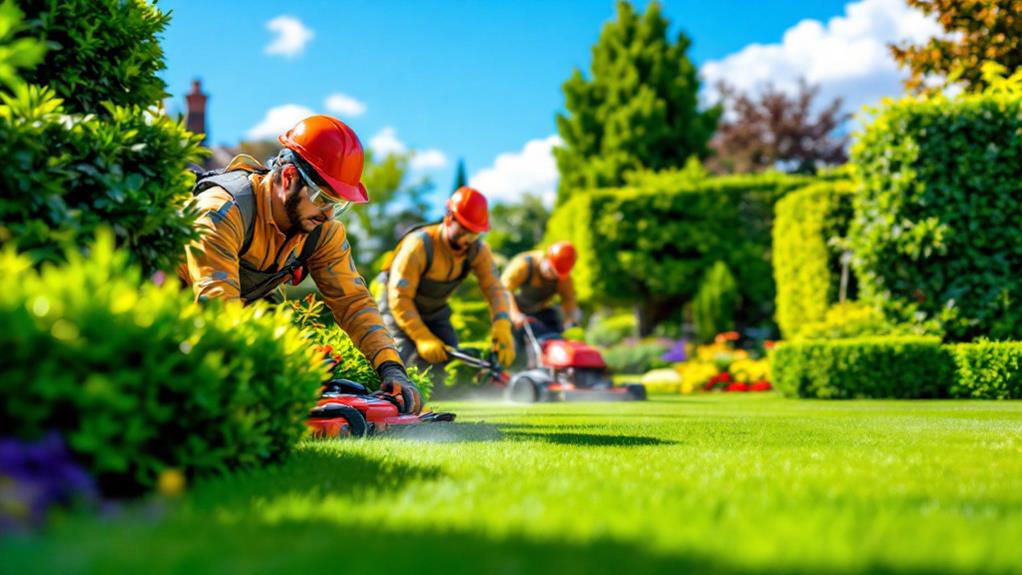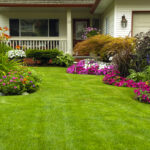Guarantee the safety of your lawn care crew by equipping them with protective gear, like cut-resistant gloves and slip-resistant boots. Regular safety meetings keep everyone informed about potential risks while open communication encourages vigilance. Conduct routine equipment inspections, focusing on functionality, to prevent mechanical failures. Teach proper tool usage and maintenance to avoid injuries. Emphasize staying hydrated and rested to maintain alertness. Foster awareness of surroundings, including terrain and overhead hazards. Handle chemicals responsibly by reviewing data sheets and having spill plans. Guarantee all emergency plans are up-to-date. These proactive steps form the foundation of a safer work environment, with more detailed strategies available.
Wear Appropriate Protective Gear
When tackling lawn care tasks, ensuring your safety starts with wearing appropriate protective gear.
First, prioritize gloves selection. Choose durable, cut-resistant gloves that provide both protection and dexterity. This choice shields your hands from sharp tools and thorny plants, reducing the risk of injury.
Next, recognize the footwear importance. Opt for sturdy, slip-resistant boots that offer ankle support. Proper footwear prevents slips on wet grass and uneven terrain, minimizing the chance of sprains or falls. Additionally, consider steel-toed boots if you’re working with heavy equipment.
Beyond gloves and footwear, don’t overlook eye protection and hearing protection. Each piece of gear plays a significant role in safeguarding your well-being.
Equip yourself correctly to confidently and safely handle all lawn care operations.
Conduct Safety Meetings Regularly
Regularly conducting safety meetings is essential for maintaining a secure environment during lawn care activities. These meetings reinforce a robust safety culture and guarantee everyone is on the same page.
Begin each session by reviewing any recent incidents and discussing how they could have been prevented. Encourage open team communication, allowing crew members to voice concerns or suggest improvements.
Highlight the importance of following established protocols and procedures. Use visual aids or demonstrations to illustrate key safety practices, making the information more engaging and memorable.
Set clear objectives for each meeting, and conclude with actionable steps. By prioritizing these meetings, you’re fostering a proactive approach to safety, assuring your team remains vigilant and well-informed.
Implement Equipment Inspections
The cornerstone of effective lawn care safety is routine equipment inspections. By conducting these inspections, you guarantee that each tool and machine operates at peak performance, reducing the risk of accidents.
First, establish thorough maintenance schedules. Regularly scheduled checks will help you catch potential issues early, before they turn into costly hazards. Always refer to equipment manuals for specific inspection guidelines. These manuals provide detailed instructions on what to look for and how often checks should occur.
Pay close attention to wear and tear on blades, belts, and other critical components. Verify that safety features, like guards and shields, are intact and functioning. Workplace assessments are crucial to ensure that all safety protocols are being followed, reducing the risk of injury during lawn mowing operations.
Use Tools Correctly
While routine equipment inspections lay the groundwork for a safe lawn care environment, using tools correctly amplifies safety and efficiency.
Always prioritize tool maintenance by cleaning and lubricating moving parts regularly. This prevents unexpected malfunctions and extends the lifespan of your equipment.
When handling tools, apply ergonomic techniques to minimize strain and reduce injury risk. Adjust tool handles to a comfortable height and use a firm grip to maintain control.
Ascertain you’re familiar with each tool’s manual, understanding its specific operational guidelines. Never bypass safety features or take shortcuts.
If you’re unsure about a tool’s function, seek guidance or training. Proper usage not only enhances performance but also protects you and your crew, fostering a culture of safety.
Stay Hydrated and Rested
Maintaining ideal hydration and ensuring adequate rest are essential components of effective lawn care safety. When you’re working under intense sun exposure, your body’s water loss increases, making it vital to take regular hydration breaks.
Drink water consistently throughout your shift, even if you don’t feel thirsty, to prevent dehydration. It’s not just about drinking water, though. Include electrolyte-rich beverages to replace lost salts and minerals, enhancing your body’s hydration levels.
Equally important is ensuring you’re well-rested. Fatigue can impair your concentration and judgment, increasing the risk of accidents. Aim for 7-9 hours of sleep each night and take short breaks throughout your workday to recharge.
Be Aware of Surroundings
Always keep your surroundings in mind when working on lawn care tasks to secure maximum safety.
Develop situational awareness by regularly scanning the work area for any changes or potential threats. Pay attention to environmental hazards such as uneven terrain, hidden tree roots, or wet grass that could cause slips or falls.
Be mindful of overhead branches and power lines, guaranteeing you maintain a safe distance while using tall equipment. Listen for any unusual noises, like approaching vehicles or disturbed wildlife, which might indicate danger.
Position tools and equipment safely, avoiding clutter that could lead to tripping. Communicate clearly with team members about any identified risks to guarantee everyone is informed.
Your proactive approach keeps you and your team safe.
Handle Chemicals Safely
When handling lawn care chemicals, it’s crucial to follow precise safety protocols to protect yourself and the environment.
First, always use proper chemical storage. Store them in a secure, well-ventilated area, away from direct sunlight and extreme temperatures. Verify all containers are tightly sealed and clearly labeled, preventing accidental misuse.
Before using any chemicals, review the Material Safety Data Sheets (MSDS) for specific handling instructions and potential hazards.
In case of a spill, act swiftly with an effective spill response plan. Equip your crew with spill kits containing absorbent materials, protective gloves, and goggles.
Immediately contain the spill, preventing it from reaching drains or soil. Clean the area thoroughly and dispose of contaminated materials according to local regulations.
Practice Ladder and Lift Safety
Using a ladder or lift effectively can greatly enhance the safety and efficiency of your lawn care tasks.
First, confirm ladder stability by setting it on a flat, stable surface. Always inspect the ladder for defects before use. Maintain three points of contact while climbing and never overreach.
For lifts, prioritize lift maintenance by conducting routine checks on hydraulic systems, controls, and safety features. Confirm all operators are trained and understand the equipment’s load limits.
Keep a clear surrounding area to prevent accidents. When positioning a lift, maintain a safe distance from power lines and other hazards.
Develop Emergency Response Plans
Preparation is key when it comes to developing effective emergency response plans for lawn care activities. Start by identifying potential hazards specific to your work environment.
Once identified, establish clear procedures for each scenario. Conduct regular emergency drills to guarantee your crew knows how to respond swiftly and safely. During these drills, practice crisis communication to guarantee everyone understands the signals and knows their roles during an emergency.
Keep your communication tools, like radios or mobile phones, in good working order and fully charged. It’s essential to review and update your emergency plans regularly, incorporating feedback from your team to improve procedures.
Conclusion
In landscaping, safety’s not just a practice—it’s a shield protecting every crew member. By donning the right gear, staying alert, and handling equipment with care, you’re building a fortress against accidents. Regular safety meetings and inspections are your compass, guiding you through each task. Stay hydrated and rest well, as fatigue is a silent thief of focus. With these precautions, your team’s productivity and well-being will flourish like a well-tended garden.



